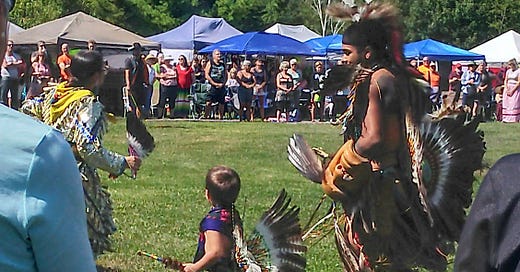Pow-Wow Wasoqopa’q First Nation (Formerly Acadia First Nation)
September 2022, Gold River, Nova Scotia
Photo Taken by: S. Mackintosh
One great way for non-indigenous Canadians to learn more about indigenous culture, participate in cultural events and show support for indigenous people is to attend a Pow-Wow. These events happen all across Canada. Many educational institutions (Universities and Colleges) host Pow-Wows to celebrate the graduation of Indigenous students and as an opportunity to honour indigenous Canadians.
A Pow Wow is a celebration of culture where people come together for several days to dance and sing and honour the traditions of their ancestors. While the origins of the term are not clear the annual Pow-Wow has evolved into being an important social gathering each year. Gatherings similar to Pow-Wows existed in most indigenous communities long before first contact with Europeans. Dances were usually associated with one of four occasions: religious ceremonies, homecoming celebrations honouring successful war parties, celebrations of new or reaffirmed alliances, and events sponsored by various warrior societies or extended family groups. The major difference between these historic events and modern Pow-Wows is that with pre-contact events only tribal members and those from friendly neighbouring tribes were allowed on the dance grounds. Today everyone is welcome to participate.
The term “Pow-Wow” can be traced to the Algonquin language. It was originally pronounced “pauau” or “pau wau” and referred to a gathering of medicine men and spiritual leaders in a curing ceremony. The early European settlers thought that the term referred to a council or to a large gathering of indigenous peoples. Thus, the use of the word spread throughout North America and has become accepted by indigenous people as a proper term for annual social gatherings. It should be noted that the casual use of the term to refer to any non-indigenous meeting is unacceptable and is considered an inappropriate appropriation of part of indigenous culture.
We should also note that The Indian Act (1876) prohibited the celebration of ceremonies and dance. Specifically, the Act was amended in 1895, to prohibit “any Indian festival, dance or other ceremony,” which would include Pow-Wows and the sun dance. Another amendment in 1914 outlawed dancing off-reserve, and in 1925, dancing is outlawed entirely. At that time through the Department of Indian Affairs and its Indian agents, the Indian Act generally gave the government sweeping powers with regards to First Nations identity, political structures, governance, cultural practices and education. The goal was to assimilate indigenous people into non-Indigenous society by controlling how First Nations communities expressed their identities through governance structures, use of their language and cultural ceremonies.
Despite this, Pow-Wows continued in secret. After World War II Canadian society began to question its oppression of indigenous social norms and a period of ascendency began for indigenous people and recognition of their rights. This movement was reflected in a new and revised Indian Act, given royal assent on 20 June 1951, which removed some of the most offensive political, cultural and religious restrictions including bans on ceremonies like Pow-wows, the potlach and the sun dance. Now, Pow-Wows have returned to prominence as a forum for community and celebration.
If you attend a Pow-Wow, a few rules of etiquette are important to note and respect:
The Grand Entry and the Opening Prayer signal the beginning of the Pow-Wow. The Opening Prayer is always performed by an Elder, and the drum takes centre stage as the most important part. Attendees should be punctual for these and respect the importance of the ceremonial aspects of them.
Photographs should not be taken during ceremonial events. Photographs may be taken of dancers but one should always ask permission first.
Alcohol and drugs are strictly forbidden. Pow-Wows are meant, in part, as times for healing and so the use of intoxicants is inconsistent with that intent.
The Anishinaabeg have a teaching that the Creator separated the path of man and wolf for a good reason. These paths will converge again, but until that time dogs and other pets should be left at home.
An “Intertribal” is a dance where everybody is welcome to enter the arena and dance. Everybody includes Indigenous, non-Indigenous, in regalia, no regalia, young, old …everybody come out and dance! The Emcee will let you know when these are taking place throughout the day.
A dancer’s regalia is how they dress their spirit. It’s a special piece of handmade clothing and accessories that holds spiritual significance to the dancer and is adorned with beading (for example) that has taken many hours (or even years) to assemble. Be respectful and always ask before taking photos or touching.
Don’t forget your tobacco. Offering tobacco to an Elder or dancer before a question is a sign of tremendous respect.
Browse the local vendors. When you’re buying from the artisans, you’re supporting Indigenous families and their communities.
Recognize different traditions. Traditions change from nation to nation. Sometimes, a local nation holds a cultural expo of their specific traditions — such as a sacred fire — or different dances that are specific to that region, like the smoke dance, switch dance or clown dance. Embrace the diversity!
A Pow-Wow is a spiritual experience for those performing, but you may not fully understand what’s going on if you’re new to these events. If you have any questions, just respectfully ask.
While Pow-Wows can be held at any time during the year typically most fall between March and September. They are fun festive events. Attending a Pow-wow is an opportunity to learn more about indigenous culture, experience a cultural event and demonstrate support for our indigenous communities. So, part of a suggested path to Truth and Reconciliation is to make a point of attending a Pow-Wow.




